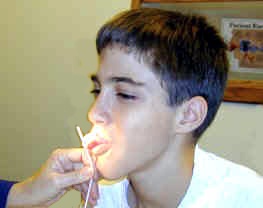Summary: Deviant swallow and/or orofacial hypotonicity (facial
droop) can adversely affect jaw structures and positioning of teeth with a
negative effect on ability to properly masticate (chew), swallow and
produce speech sounds.
Definition: The tongue moves forward
in an exaggerated way during speech, chewing and swallowing. The tongue
may also lie too far forward at-rest. The tongue may push against the
teeth or protrude through the teeth. This pressure interferes with normal
tooth eruption and alignment of the teeth and jaws. Continuous forward
tongue posture causes a child to look, speak and swallow differently.
Causes: The most frequent cause of
OMD is a blocked airway from enlarged tonsils, adenoids or from allergies.
An open-mouth breathing pattern can become habituated and continue even
after successful medical treatment of the airway blockage. Secondary
causes include deviant dental alignment, excessive thumb sucking, lip
licking, teeth clenching and grinding.
Remediation for OMD
- Medical management for nasal airway
blockage.
- Dental/orthodontic intervention for
alignment of teeth and jaws
- Speech treatment by speech pathologist
to help both speech and swallowing problems. Typically this follows
medical treatment and may precede, continue in conjunction with
orthodontic treatment or follow completion.
 The remedial program I use
includes: The remedial program I use
includes:
- Initial evaluation
of lip,
palate, tongue and facial muscles both at rest and during complex
movements needed for both clear speech and adequate swallowing.
- Monthly therapy sessions
to
demonstrate and teach at-home exercises to:
- Increase awareness of oral, lingual and
facial muscles and postures.
- Improve oral and facial muscle strength
and coordination.
- Establish normal speech articulation and
swallowing patterns.
For children and adolescents a parent
attends the therapy sessions to learn the exercises and then assists in
the daily exercises at home. Typically the process is completed in 6
months with consistent at-home practice.
3. Follow-up evaluation six months post
completion of the training to
ensure that the normal speech and swallowing
patterns have continued.
For further information, contact
Michele Wilson,
Ph.D.
|